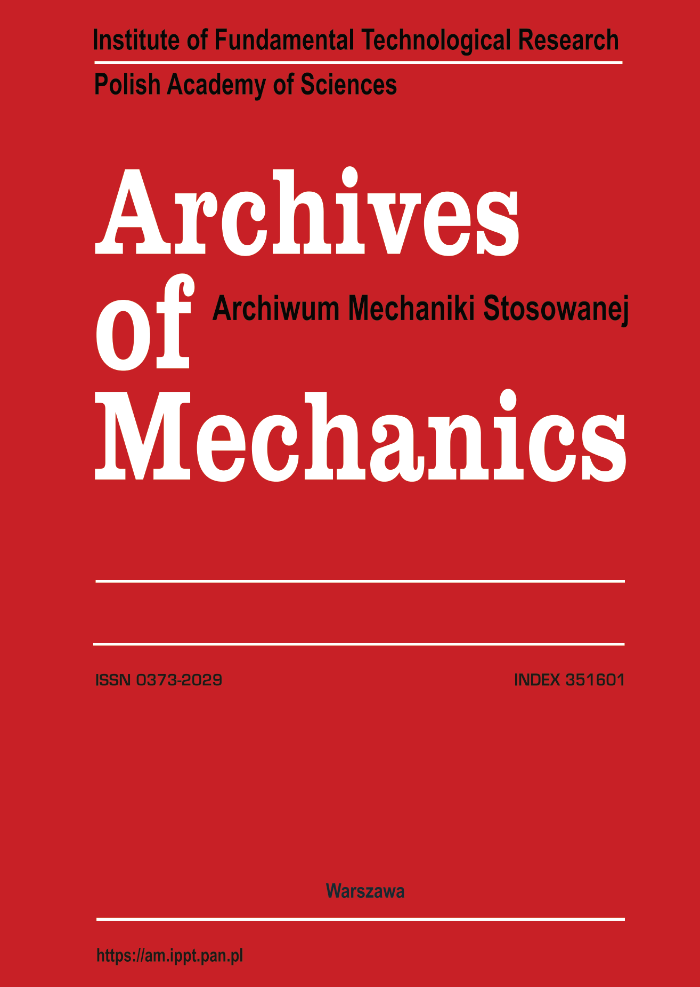Abstract
An approach to homogenization of particulate composite materials is proposed. The mean-field assumption for averaging over phases is combined with numerical calculations of strain-concentration tensors, thus making it independent from the analytical Eshelby solution for ellipsoidal inclusions. The fast multipole boundary element method (FMBEM) is applied to 3-D elasticity and two-phase composites. As opposed to the finite element method (FEM), this method allows for easy modeling of large structures without the need to discretize volumes. Single-inhomogeneity problems are solved, and the calculated strain concentration tensors are used in the averaging formula under the assumption of the Mori–Tanaka approach. An interpolative scheme involving the inverse Mori–Tanaka assumption, known from the literature, is also applied to increase the accuracy of the approximation for higher volume fractions of particles. Examples include composites with spherical and cubic particles, and hybrid materials with auxetic components. The results are consistent with analytical solutions and RVE/FEM models.
Keywords:
3-D particulate composites, linear elasticity, mean-field homogenization, strain concentration tensor, fast multipole boundary element methodReferences
- J.D. Eshelby, The determination of the elastic field of an ellipsoidal inclusion, and related problems, Proceedings of the Royal Society A, 241, 1226, 376–396, 1957, https://doi.org/10.1098/rspa.1957.0133.
- T. Mori, K. Tanaka, Average stress in matrix and average elastic energy of materials with misfitting inclusions, Acta Metallurgica, 21, 571–574, 1973, https://doi.org/10.1016/0001-6160(73)90064-3.
- Y. Benveniste, A new approach to the application of Mori–Tanaka’s theory in composite materials, Mechanics of Materials, 6, 147–157, 1987, https://doi.org/10.1016/0167-6636(87)90005-6.
- T. Chen, G.J. Dvorak, Y. Benveniste, Mori–Tanaka estimates of the elastic moduli of certain composite materials, Journal of Applied Mechanics, 59, 3, 539–546, 1992, https://doi.org/10.1115/1.2893757.
- T. Mura, Micromechanics of Defects in Solids, Kluwer Academic Publishers, Dordrecht, 1987, https://doi.org/10.1007/978-94-009-3489-4.
- S. Nemat-Nasser, M. Hori, Micromechanics: Overall Properties of Heterogeneous Materials, Elsevier, Amsterdam, 1999.
- O. Pierard, C. Friebel, I. Doghri, Mean-field homogenization of multi-phase thermo-elastic composites: a general framework and its validation, Composites Science and Technology, 64, 10–11, 1587–1603, 2004, https://doi.org/10.1016/j.compscitech.2003.11.009.
- J. Qu, M. Cherkaoui, Fundamentals of Micromechanics of Solids, John Wiley & Sons, New Jersey, 2006, https://doi.org/10.1002/9780470117835.
- T.I. Zohdi, P. Wriggers, An Introduction to Computational Micromechanics, Springer-Verlag, Berlin–Heidelberg, 2008, https://doi.org/10.1007/978-3-540-32360-0.
- R.D. Bradshaw, F.T. Fisher, L.C. Brinson, Fiber waviness in nanotube-reinforced polymer composites – II: modeling via numerical approximation of the dilute strain concentration tensor, Composites Science and Technology, 63, 11, 1705–1722, 2003, https://doi.org/10.1016/S0266-3538(03)00070-8.
- L. Brassart, I. Doghri, L. Delannay, Homogenization of elasto-plastic composites coupled with a nonlinear finite element analysis of the equivalent inclusion problem, International Journal of Solids and Structures, 47, 5, 716–729, 2010, https://doi.org/10.1016/j.ijsolstr.2009.11.013.
- G. Srinivasulu, R. Velmurugan, S. Jayasankar, A hybrid method for computing the effective properties of composites containing arbitrarily shaped inclusions, Computers & Structures, 150, 63–70, 2015, https://doi.org/10.1016/j.compstruc.2014.12.010.
- P. Sadowski, K. Kowalczyk-Gajewska, S. Stupkiewicz, Consistent treatment and automation of the incremental Mori–Tanaka scheme for elasto-plastic composites, Computational Mechanics, 60, 493–511, 2017, https://doi.org/10.1007/s00466-017-1418-z.
- W. Ogierman, Hybrid Mori–Tanaka/Finite Element Method in homogenization of composite materials with various reinforcement shape and orientation, International Journal for Multiscale Computational Engineering, 17, 3, 281–295, 2019, https://doi.org/10.1615/IntJMultCompEng.2019028827.
- W. Ogierman, A new model for time-efficient analysis of nonlinear composites with arbitrary orientation distribution of fibres, Composite Structures, 273, 114310, 2021, https://doi.org/10.1016/j.compstruct.2021.114310.
- W. Ogierman, A data-driven model based on the numerical solution of the equivalent inclusion problem for the analysis of nonlinear short-fibre composites, Composites Science and Technology, 250, 110516, 2024, https://doi.org/10.1016/j.compscitech.2024.110516.
- O. Eroshkin, I. Tsukrov, On micromechanical modeling of particulate composites with inclusions of various shapes, International Journal of Solids and Structures, 42, 2, 2005, https://doi.org/10.1016/j.ijsolstr.2004.06.045.
- A. Trofimov, B. Drach, I. Sevostianov, Effective elastic properties of composites with particles of polyhedral shapes, International Journal of Solids and Structures, 120, 157–170, 2017, https://doi.org/10.1016/j.ijsolstr.2017.04.037.
- A. Markov, A. Trofimov, I. Sevostianov, A unified methodology for calculation of compliance and stiffness contribution tensors of inhomogeneities of arbitrary 2D and 3D shapes embedded in isotropic matrix – open access software, International Journal of Engineering Science, 157, 103390, 2020, https://doi.org/10.1016/j.ijengsci.2020.103390.
- Q.H. Qin, Micromechanics–BE solution for properties of piezoelectric materials with defects, Engineering Analysis with Boundary Elements, 28, 7, 809–814, 2004, https://doi.org/10.1016/j.enganabound.2003.12.006.
- Q.H. Qin, Material properties of piezoelectric composites by BEM and homogenization method, Composite Structures, 66, 1–4, 295–299, 2004, https://doi.org/10.1016/j.compstruct.2004.04.051.
- G. Dziatkiewicz, Analysis of effective properties of piezocomposites by the subregion BEM–Mori–Tanaka approach, Mechanics and Control, 30, 4, 194–202, 2011.
- P. Fedeliński, R. Górski, G. Dziatkiewicz, J. Ptaszny, Computer modelling and analysis of effective properties of composites, Computer Methods in Materials Science, 11, 1, 3–8, 2011, https://doi.org/10.7494/cmms.2011.1.0304.
- T. Czyż, G. Dziatkiewicz, P. Fedeliński [ed.], R. Górski, J. Ptaszny, Advanced Computer Modelling in Micromechanics, Silesian University of Technology Press, Gliwice, 2013.
- J. Ptaszny, A fast multipole BEM with higher-order elements for 3-D composite materials, Computers & Mathematics with Applications, 82, 148–160, 2021, https://doi.org/10.1016/j.camwa.2020.10.024.
- G. Lielens, P. Pirotte, A. Couniot, F. Dupret, R. Keunings, Prediction of thermo-mechanical properties for compression moulded composites, Composites Part A: Applied Science and Manufacturing, 29, 1–2, 63–70, 1998,
https://doi.org/10.1016/S1359-835X(97)00039-0. - I. Shufrin, E. Pasternak, A.V. Dyskin, Hybrid materials with negative Poisson’s ratio inclusions, International Journal of Engineering Science, 89, 100–120, 2015, https://doi.org/10.1016/j.ijengsci.2014.12.006.
- K. Long, X. Du, S. Xu, Y.M. Xie, Maximizing the effective Young’s modulus of a composite material by exploiting the Poisson effect, Composite Structures, 153, 593–600, 2016, https://doi.org/10.1016/j.compstruct.2016.06.061.
- J. Schjèdt-Thomsen, R. Pyrz, The Mori–Tanaka stiffness tensor: diagonal symmetry, complex fibre orientations and non-dilute volume fractions, Mechanics of Materials, 33, 10, 531–544, 2001, https://doi.org/10.1016/S0167-6636(01)00072-2.
- C.A. Brebbia, J. Dominguez, Boundary Elements an Introductory Course, McGraw-Hill, New York, 1992.
- T. Burczyński, Boundary Element Method in Mechanics, Scientific and Technical Publishing WNT, Warsaw, 1995 (in Polish).
- X.W. Gao, G. Davies, Boundary Element Programming in Mechanics, Cambridge University Press, Cambridge, 2002.
- G. Beer, I. Smith, C. Duenser, The Boundary Element Method with Programming for Engineers and Scientists, Springer–Verlag, Wien–New York, 2008, https://doi.org/10.1007/978-3-211-71576-5.
- Z. Yao, F. Kong, X. Zheng, Simulation of 2D elastic bodies with randomly distributed circular inclusions using the BEM, Electronic Journal of Boundary Elements, 1, 2, 270–282, 2003, https://doi.org/10.14713/ejbe.v1i2.761.
- L. Greengard, V. Rokhlin, A fast algorithm for particle simulations, Journal of Computational Physics, 73, 2, 325–348, 1987, https://doi.org/10.1016/0021-9991(87)90140-9.
- Y.J. Liu, Fast Multipole Boundary Element Method Theory and Applications in Engineering, Cambridge University Press, 2009, https://doi.org/10.1017/CBO9780511605345.
- J. Ptaszny, M. Hatłas, Evaluation of the FMBEM efficiency in the analysis of porous structures, Engineering Computations, 35, 2, 843–866, 2018, https://doi.org/10.1108/EC-12-2016-0436.
- L.H. Dai, Z.P. Huang, R. Wang, Explicit expressions for bounds for the effective moduli of multi-phased composites by the generalized self-consistent method, Composites Science and Technology, 59, 11, 1691–1699, 1999, https://doi.org/10.1016/S0266-3538(99)00031-7.
- S. Torquato, Random Heterogeneous Materials, Springer-Verlag, New York, 2002, https://doi.org/10.1007/978-1-4757-6355-3.
- A. Gillman, G. Amadio, K. Matouš, T.L. Jackson, Third-order thermo-mechanical properties for packs of platonic solids using statistical micromechanics, Proceedings of The Royal Society A, 471, 20150060, 2015, https://doi.org/10.1098/rspa.2015.0060.







